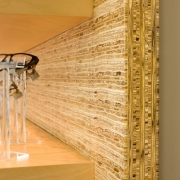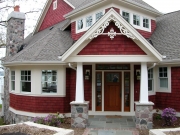The Denver Art Museum may well be the most prominent expression of Denver’s cultural heart. Daniel Libeskind’s 146,000 sq. ft. extension to the museum, The Frederic C. Hamilton Building, was a joint venture with the Davis Partnership and houses Modern, Contemporary, Oceanic, and African Art collections. The original museum, which opened in 1971, was Italian architect Gio Ponti’s first American commission and boasted an exterior of Italian tile and the innovation of stacking its galleries vertically, which sought to combat the “museum fatigue” that resulted from traversing the long horizontal layout typical of museums at the time.
Jeff Wilson Everyday DIY Blog
Let's talk DIY
This is the place to rant, rave, brag, belly-ache, crack a joke, procrastinate, and delve into the metaphysical aspects of the DIY mindset. We’re off the map, on a tangent, and frequently off topic. This is the stuff we don’t show on TV.
After Bids: Contract Administration at the Start of Construction
The time between receiving bids (or a proposal for sole source work) and the start of construction is a busy time for the contractor, the owner, and the design professional. The design professional must quickly check the bids and verify that the low bidder truly has the qualifications to do the work, then prepare the contract documents for signatures. The owner needs to proceed through the necessary steps to award the project, which include having financing ready. The low bidder must begin to expand upon the data assembled during the bid phase and prepare for mobilization.
Interior Painting: Tips and Techniques
In our last article on DIY painting basics, we discussed setting up an effective workspace and managing the workflow. We're now ready to work, and we'll discuss tips on preparation and finishing your interior painting project. Painting serves two purposes -- to beautify and to protect surfaces. Beautification takes a more prominent role in interior painting than in exterior, where protection is your higher concern. Proper surface preparation is equally important in achieving both purposes. Preparation is the most time-consuming and difficult aspect of any painting job, although it is also the most important. Proper preparation will produce a finish that will look great and last far longer than poor preparation will.
The Bertschi School, an independent elementary school in Seattle, Washington, has a history of emphasizing sustainability. In 2007, it was the first school in the state to have an elementary classroom building awarded LEED Gold certification. Now, with a new 1,425 sq. ft. science classroom scheduled for completion in November, the school is attempting to comply with an even more stringent green building rating system, the Cascadia Region Green Building Council’s Living Building Challenge.
Case Study: Cuyahoga Metro Housing Authority Utilizes BAS
Michael Hughes is Chief of the Construction Department for the Cuyahoga Metropolitan Housing Authority (CMHA) in Cleveland, Ohio. He’s also one of the people most familiar with CMHA’s Building Automation System (BAS). In this lead article initiating a case study with CMHA, we’ll provide a summary overview of their BAS, which was installed by Siemens Building Technologies. In future articles, we’ll take some more in-depth journeys with Mr. Hughes into the BAS, including the daily use of the system. Throughout this series, we’ll cover some detailed time and cost-savings scenarios that BASs offer to building owners.
Contract Administration: Understanding Contract Documents
Tell someone that you work in construction -- heavy construction, that is -- and they most likely will have a mental image of earth-moving equipment, trenches, concrete, and asphalt. Paperwork may not come to mind, nor contracts or documents. Yet the success of a construction project depends not only on the work at the site but also on the paper documentation that defines what must be done.
Painting Basics
When I think about DIY painting basics, I think about process and procedure -- setting up an effective work space and job sequencing. I have been at this business for a long time, and I have seen and learned a lot. I have met homeowners of all competencies, each of whom seemed to lack this understanding of process and procedure. Throughout this series, we will look at interior and exterior application techniques, including tips and tricks. The goal is to help the DIYer produce a higher-quality result using fewer resources.
Going Green: Sustainable Finishes
The number of green design materials available has exploded in recent years. Products that used to be offered in limited colors or designs are now as varied as their traditional counterparts. Because of consumer demand, sustainable painting, flooring, and countertop products that might have been less durable and expensive in the past are now stronger, longer-lasting, and often more affordable.
Denver’s Union Station is a regional multi-modal hub that embodies everything about Denver’s upbeat future. The Union Depot & Railroad Company built Denver's first Union Station at the city's northwest edge. It cost $525,000 to build and opened on June 1, 1881. Union Station houses the Amtrak service and, more uniquely, the Ski Train, a local favorite that takes skiers on an entertaining ride through the Rockies to the Winter Park Ski Resort.
How to Read Flood Zone Maps
Flooding occurs when water exceeds normal cyclical levels in areas that are largely considered to be dry land. Flooding can result in damage to property and subsequent expenses. Flood maps illustrate which areas of a region are more likely to flood than others in a given year and are used by insurance companies to determine flood insurance premiums.
Cellular PVC Trim: The Durable Aesthetic Option
Coil Wrap vs. Cellular PVC Trim
Exterior trim is an essential component of a home's appearance and resale value. More importantly, it provides protection from moisture at corners and around window and door openings, where material transitions occur. Traditionally, exterior trim has been made of wood due to its low initial cost, ease of installation, and familiarity as a building material. However, several materials are available as a replacement for wood trim, including coil wrap and cellular PVC trim.
Cranes Can Kill: Almost Another Statistic
I learned a hard lesson regarding the required use of spreader bars when lifting heavy angular objects with a crane: I was placed in harm’s way and witnessed the destruction of over $20,000 worth of property during a construction mishap. Fortunately, following some tense seconds, there were zero injuries and several lessons learned.











